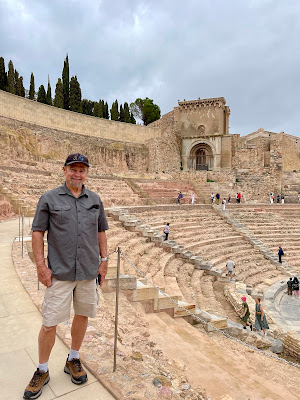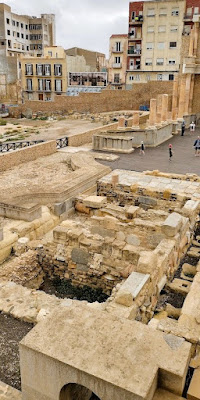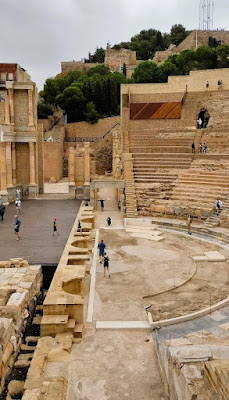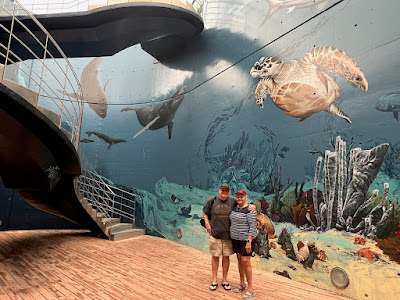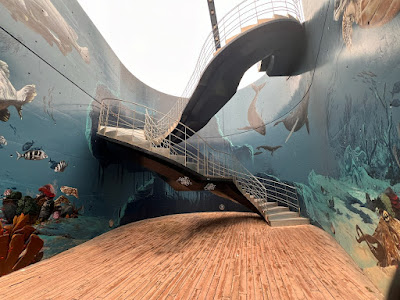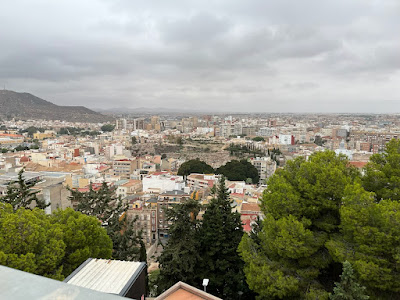While we had been enjoying great meals and entertainment on board Caribbean Princess with our friends Mike and Linda, it wasn't until Cartagena that we finally coordinated heading ashore together for the first time since Cherbourg, which had not turned out exactly as we thought we'd scheduled.
Julie and Linda hatched the plan for Cartagena over Cosmos and Bailey's Rocks the prior night, while Mike and I busied ourselves with whatever old Lions find important, like guessing song titles in trivia games or being in awe of how far we've traveled since first grade to re-learn fascinating history we somehow found boring in grade school.
The four of us met in the International Cafe at 10 AM and headed ashore. This became the template for the next few ports.
Despite looming clouds, jackets were not required by the time we went ashore. We had very comfortable temperatures and no precipitation for exploring beautiful Cartagena. Score one for the oft-maligned weather forecasters!
As with Malaga, the strategic location with large natural harbor and sunny climate made it a perfect place for ancient peoples to flourish.
Evidence of human ancestors dating clear back to 1,300,000 years ago have been found in Cartagena.
Fast-forwarding to a documented period of history, a Carthaginian General arrived in this port town in 227 BC.
He re-named it New City, which in their language was confusingly the same name as their nation-state's capital, Carthage.
If Carthage rings a bell, you will recognize the name Hannibal, who was about twenty years-old in 227 BC. He was not the general who dubbed this Spanish port as Carthage, but Hannibal is undoubtedly the most well-known Carthaginian.
Nine years later, Hannibal famously rode to fame by crossing the Alps into present-day Italy with African elephants, beginning that renowned campaign in what is modern day Cartagena.
 |
| 218 BC Map Copied from Wikipedia |
The Carthaginians are purportedly the same seafaring people that The Holy Bible calls the Phoenicians. They were allies of the Israelites.
I never considered that Biblical people might have sailed to western Europe until a guide in Glastonbury fascinated me with an otherwise unrelated story about Jesus Christ and Joseph of Arimathea. It now seems obvious that travel by sea made distant lands easier to reach than grueling overland trips through the desert.
When the Roman Empire struck back and captured all of Iberia (Spain) in about 209 BC, they gave Cartagena the Latin name Carthago Nova, which translates as New Carthage. They subsequently re-named it Cartago Spartaria. Over the years, that moniker morphed into the current name, Cartagena.
Our primary destination for our day in Cartagena was Castillo de la Concepción, a castle at the top of a hill. On our walk there, we encountered a tunnel with surprising art murals of sea life.
We spent several minutes enjoying this unexpected, unique visual treat. Never be so fixated on your objective that you skim through or perhaps ignore incredible sights you pass through on your way.
Rather than hiking up a long ramp, we took an elevator in a linked-metal column up to the castle. As we rode up, we couldn't help noticing a large structure we at first thought to be a Roman coliseum but was in fact a large bullring that had been abandoned by the government in 1986.
We had similarly been able to see a bullring on the road to the castle in Malaga, and that one is still in operation, nixing any conjecture that the one in Cartagena was shuttered due to some national outrage about the sport which some who are not steeped in the culture now consider barbaric and cruel.
The views from the hilltop undoubtedly offered great military advantage in the age before air warfare.
For tourists, that hilltop location provides outstanding panoramic views.
Peacocks by the castle provided another unexpected splash of colorful beauty.
I wasn't watching the clock, but I think we spent two or three hours appreciating the castle grounds.
Before walking back to the ship, we stopped to visit Cartagena's Roman Theater.
We have seen similar remains in many cities once ruled by the Roman Empire. Romans built theaters, public baths, athletic fields and other structures in key cities of regions being civilized, a cultural shock-and-awe approach to win hearts and minds of conquered regions. In any case, Roman Theaters are always impressive.
Strange how such landmarks of civilization are frequently buried for millennia only to be rediscovered during new construction. Cartagena's 6,000-spectator-capacity theater constructed between 5 and 1 BC began to be excavated in 1988. As real estate agents like to say, "Location, location, location."
In the beautiful harbors we visited, our enormous cruise ship towered over not only yachts but tall buildings, and if anyone had never seen one, it undoubtedly would inspire awe, even if Caribbean Princess is more of a mid-sized ocean liner these days.





































